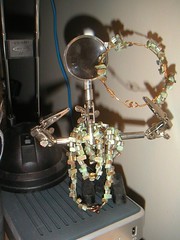I bought a juicer recently. At the time the refurbished Waring JEX328 was at $25 from Amazon, and that seemed a perfect pricepoint for something i wasn’t sure i’d use. (And a great deal since we could use our “prime” free shipping. Right now, there’s an Amazon vendor selling at $48 and another at $100, not available for prime shipping.)
When i made the first juice batch, i was struck by how moldable and fine was the carrot pulp. Perfect for paper making. Last night i tasted the pulp. It tastes like cardboard. So i rolled some out and i’ve mixed a little salt in some other and molded a vessel (vase? bowl?). I popped the mini-sheets in the convection toaster oven and ran around 150° for ten minutes. They feel the consistency of damp cardboard, like is used for cereal boxes.
It seems worth digging out the old papermaking kit and giving it a go. That just makes small sheets; i may be interested in a 8.5 x 11 mold.
The amount of pulp created is significant, though, and could create a *ton* of paper. I’m attracted to the thought of disposable carrot pulp bowls and plates: carrot machie, if you will.
Skimming resources, it’s clear that there are plenty of additives to make things “better” but i think i’ll start with just the pulp and see what happens. I initially thought that i’d want to add sizing (a starch, white glue, or gelatin — not rosin-alum because that degrades into the “acid” that makes papers age) to reduce ink bleed. But it seems like it might be better to add a surface treatment after making the paper: painting with a gelatin or white glue or starch mix, or using the calligraphy rosin.
It seems more likely that i’d need to treat the paper. After reading a great deal about boiling plant materials with ash (but never why), this resource explains that the soda or simple wood ash is to remove the lignin — another acid causing substance.
I thought it was to simply make pulping easier.
Reading notes follow.
Read the rest of this entry »


